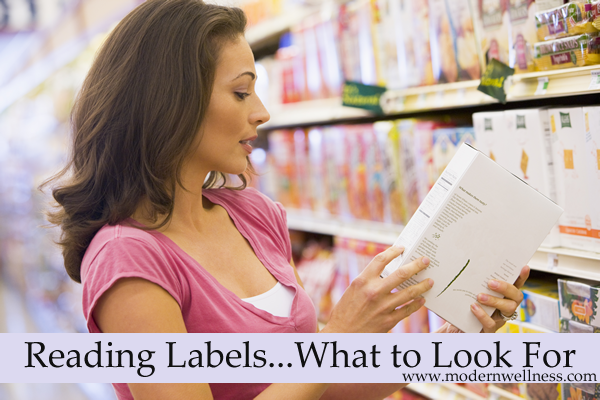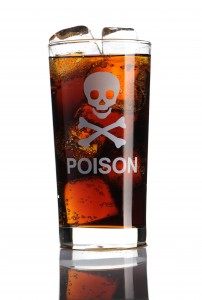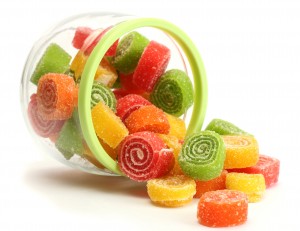Reading Ingredient Labels – What To Look For

Reading labels wasn’t always a hobby of mine. I used to buy what looked yummy! I think that is how most of the general population buys their food. I thought that food makers cared about their ingredients and would put things in them that made me and my family healthy. Then I realized that they were putting in ingredients that were cheap or addicting. It was a sad day when I realized that some of the staple items in my pantry were going in the garbage never to return again.
Since then I’ve become a pro at reading labels. I walk the aisles of a store and I don’t know if I should feel anger or sadness at what I find. I now find that I read labels of food at other people’s houses not realizing I’m even doing it. There are some ingredients that I’m just not okay ingesting and even more so I’m not okay with my children ingesting. Processed chemicals have no place in the human diet. They are toxic and have serious side effects. People ask me all the time what I’m looking for when I read labels. Here are the top 5.
-
High Fructose Corn Syrup (HFCS)
 It is addicting and horrible for you to consume. There are many people who liken it to cocaine because of the refining process it goes through and the addiction it can create. The sad thing about this ingredient is that it is in EVERYTHING! Don’t believe me? Go pick five things (if you eat the standard American diet) from your cupboards, pantry, or fridge that has been packaged and was bought from the store and see how many have it in it. We are talking about syrup, graham crackers, sloppy joe mix, ketchup, cookies, crackers, stuffing, sauces, ice cream, sushi, jams, jellies, pudding, marshmallows, candy, gum, chocolate, salad dressing, soft drinks, bread, baked beans, pickles, cereal, fruit snacks, fruit drinks, sandwich spreads, whipped toppings, yogurt, applesauce, bbq sauce, marinades, soup, breakfast sandwiches, energy drinks, nuts, canned fruit, AND cough syrup, children’s acetaminophen, and cold medicine. This is not a complete list, but you get where I’m going. It. Is. In. Everything! Stop eating it. Please stop giving it to your kids.
It is addicting and horrible for you to consume. There are many people who liken it to cocaine because of the refining process it goes through and the addiction it can create. The sad thing about this ingredient is that it is in EVERYTHING! Don’t believe me? Go pick five things (if you eat the standard American diet) from your cupboards, pantry, or fridge that has been packaged and was bought from the store and see how many have it in it. We are talking about syrup, graham crackers, sloppy joe mix, ketchup, cookies, crackers, stuffing, sauces, ice cream, sushi, jams, jellies, pudding, marshmallows, candy, gum, chocolate, salad dressing, soft drinks, bread, baked beans, pickles, cereal, fruit snacks, fruit drinks, sandwich spreads, whipped toppings, yogurt, applesauce, bbq sauce, marinades, soup, breakfast sandwiches, energy drinks, nuts, canned fruit, AND cough syrup, children’s acetaminophen, and cold medicine. This is not a complete list, but you get where I’m going. It. Is. In. Everything! Stop eating it. Please stop giving it to your kids.The risks of consuming HFCS are weight gain and obesity, developing Type 2 Diabetes, hypertension and elevated (bad) cholesterol levels, severe liver damage, and risk of mercury exposure. It’s no wonder that the American population is so unhealthy when you see what this ingredient is included in. Many companies are starting to shift away from using it as an ingredient. Until it is banned you will want to be on the lookout for this toxic ingredient!
-
Artificial Color
 Our society has become so wrapped up in the way that something looks rather than if it’s good for us or not. I’m guilty of it myself. It’s funner to eat something if it looks appealing, but is it worth the risks that come with eating the foods that have artificial color in them? For me it definitely isn’t. Two years ago we cut this ingredient out of our home. Our youngest son had never had anything with food coloring in it. We went on vacation and my sweet husband got me one of my favorite (in my “past life”) road treats… Mike & Ike’s. I was so sad and torn. Here he had done this nice gesture, paid money for it, and I do love them but I also didn’t want to eat them. Guess what I did? I ate them. Not only that, I gave some to my son. I didn’t think it would do any harm in a child who had never had this ingredient before. Ha! I was wrong. He was crazy, like spastic crazy. I wasn’t sure if it was the candy or not so I tested it again the following day by giving him only a few of them. Sure enough the craziness set in again. Several months later at Halloween he was at his Grandma’s house and came home again acting like that crazy kid. I asked my older children what he ate at Grandma’s and they told me Halloween Oreos…you know the ones with orange filling. His behavior was no surprise.
Our society has become so wrapped up in the way that something looks rather than if it’s good for us or not. I’m guilty of it myself. It’s funner to eat something if it looks appealing, but is it worth the risks that come with eating the foods that have artificial color in them? For me it definitely isn’t. Two years ago we cut this ingredient out of our home. Our youngest son had never had anything with food coloring in it. We went on vacation and my sweet husband got me one of my favorite (in my “past life”) road treats… Mike & Ike’s. I was so sad and torn. Here he had done this nice gesture, paid money for it, and I do love them but I also didn’t want to eat them. Guess what I did? I ate them. Not only that, I gave some to my son. I didn’t think it would do any harm in a child who had never had this ingredient before. Ha! I was wrong. He was crazy, like spastic crazy. I wasn’t sure if it was the candy or not so I tested it again the following day by giving him only a few of them. Sure enough the craziness set in again. Several months later at Halloween he was at his Grandma’s house and came home again acting like that crazy kid. I asked my older children what he ate at Grandma’s and they told me Halloween Oreos…you know the ones with orange filling. His behavior was no surprise.In addition to behavioral changes, artificial color has also been linked to long-term health problems such as cancer (source), and they are also contributing to the obesity epidemic (source). While candy, jello, Kool-Aid, and your children’s medications may look prettier, they are causing lasting damage. It’s best to look for products that don’t have this ingredient.
-
Artificial Flavor
With the never ending list of foods that we have available to us and the diverse flavors, why on earth would we want chemicals flavoring our food? Do you realize that’s what artificial flavor is? It’s a chemical concoction just like anti-freeze, fertilizer, pesticides, and hair spray are chemical concoctions. Were you aware that the FDA has approved over 1,700 artificial flavors? I have a tendency to want to stay away from anything the FDA has approved because they are money driven, not safety driven. If a company has enough money, they can get approval. Companies are not even required to say what their “artificial flavor” consists of but it can include benzyl isobutyrate, ethyl acetate, ethyl methylphenylglycidate (petroleum derivative), methyl benzoate (petroleum derivative), hydroxyphenyl-2-butanone (source) and are used in most processed foods.
Artificial flavors have been known to cause chest pain, headaches, fatigue, nervous system depression, allergies, and even brain damage. Unfortunately, this is only the beginning of the list. Other symptoms including seizures, nausea, dizziness, and many more. (source)
The best way to avoid artificial ingredients is to read the labels. Some products even include it on the front of the packaging. It will clearly tell you that it contains “Artificial Flavors”. Steer clear!
-
Aspartame
Why this ingredient hasn’t been outlawed is beyond me. It is one of the most toxic and dangerous substances included in food products! This ingredient is also known as NutraSweet, Equal, Spoonful, and Equal-Measure. According to Mercola, aspartame accounts for 75% of the adverse reactions to food additives reported to the FDA. Some of the side effects include headaches and migraines, muscle spasms, weight gain, depression, fatigue, nausea, hearing loss, vision problems, insomnia, irritability, anxiety attacks, difficulty breathing, tinnitus, vertigo, memory loss, joint pain, and SO much more! Brain tumors, Mutiple Sclerosis, Epilepsy, Chronic Fatigue Syndrome, Parkinson’s Disease, Alzheimer’s, Mental Retardation, Lymphoma, Birth Defects, Fibromyalgia, and Diabetes can be triggered or worsened by ingesting aspartame.
-
MSG (Monosodium Glutamate)
MSG is a somewhat controversial ingredient. It is often found in oriental food, as well as soups, sauces, crackers, and dips. MSG is used as a flavor enhancer that is derived from glutamic acid. Glutamic acid is an amino acid that is found in a lot of foods and is critical for healthy brain development and function. The problem with these types of ingredients isn’t where they come from but the fact that they’ve been pulled out of their natural form and turned into a chemical substance. Two natural ingredients combined together (sodium & glutamic acid) doesn’t mean it is safe to consume and also makes it more difficult for our body to process.
There have been numerous studies testing the link between MSG and a long-list of side effects that people can experience after consuming it, including mild to severe headaches, flushed skin, weight gain, sweating, tiredness, heart palpitations, and more. Most of these studies have been inconclusive. However, the symptoms for many people are very real! Aside from avoiding these potential symptoms MSG is usually contained in food that isn’t good for you anyways, which gives an added reason to avoid it.
-
Hydrogenated Oils
Hydrogenated oils are generally oils that in their natural state are often healthy. During the process of hydrogenating the oils they are turned into poison. Common oils that are hydrogenated are palm, kernel, corn or coconut oils. Hydrogenation occurs when the oil is heated up to to several hundred degrees under intense pressure. It is then injected with a catalyst to rearrange the molecules. The catalyst used is typically a metal such as nickel, platinum, and even aluminum. What once was a liquid oil now turns into a solid, which makes it either a partially hydrogenated oil or fully hydrogenated oil. The new hydrogenated oil is only one molecule away from being plastic! Not a very appetizing idea. You may be surprised to learn that these oils can be found in margarine, vegetable shortening, non-dairy whipped dessert toppings, cake frosting, white bread, non-dairy coffee creamers, tortillas, fast food, donuts, peanut butter, and ice cream.
This ingredient will thicken your blood making it much harder for the heart to function properly and the veins to transport blood effectively which can lead to high blood pressure as well as high cholesterol.
In some studies it has been shown that such oils contributes to high cholesterol because it actually scars the internal walls of the arteries. This is due to the nickel that is often used in the hydrogenation process. This causes the body to then produce cholesterol to heal the walls of the arteries which is one reason that the plaque builds up on the arterial walls. As the walls are continually scarred this slowly shrinks the opening for blood to flow through making the heart work much harder, placing a great strain on the heart and eventually wears the heart out.
Hydrogenated oils can slow the micro circulation of blood through the brain further causing various emotional and physical ailments such an Alzheimer’s, Parkinson’s, ADHD and muddled thinking just to name a few. Remember also that one of the metals sometimes used in the hydrogenation process is aluminum which has been linked to the onset of Alzheimer’s disease in a number of studies. (source)
It is so important to be proactive with your health and especially the health of your children. No one will be looking out for them the way you should. It may not be an easy change to cut these ingredients out of your diet but it is possible. If all you can do is cut out one of them please let it be aspartame first followed by high fructose corn syrup. By eliminating these two ingredients you will have eliminated the others in large part. Our food industry is overrun with food-like products instead of real food. Take a stand and be proactive in eating food that is real instead of a chemical concoction.
What other ingredients do you feel it’s important to steer clear of? We would love to hear your thoughts.

3 thoughts on “Reading Ingredient Labels – What To Look For”
You must be logged in to post a comment.